3D Sand Printing for Casting—How Binder Jetting Shapes the Process
Binder jetting is a cutting-edge additive manufacturing technique. In this process, fine particles—often foundry sand, though metal powders and ceramic particles are also used—are bound together with a special liquid binder. This binder, typically a resin or another specialized liquid ensures, that the particles stick together securely.
The process begins with a thin layer of sand being spread across a build platform. A print head then moves across the surface, spraying binder onto specific areas based on the component’s design, as determined by the CAD data. This targeted application ensures the binder is only applied where it's needed, shaping the component layer by layer with precision.
Once the binder is applied, a drying or curing phase solidifies the bond, ensuring the component has the strength it needs to maintain structural integrity. This step guarantees the finished product is durable and ready for use. The layering continues until the component is fully formed, after which post-processing steps are required to remove excess material and refine the piece, whether by strengthening it further or performing additional machining.
Advantages of Binder Jetting
Binder jetting stands out for its remarkable flexibility and cost-effectiveness, allowing for the efficient production of complex geometries without the need for traditional tools.
With binder jetting, there is precise control over the structure and density of the printed components through a careful dosage of binder and material. This precision enables the creation of even the most intricate details and complex cavities. For casting, this brings significant advantages: molds and cores can be directly produced from CAD data, eliminating the need for conventional tools or models. This not only saves time but also cuts costs in prototype development and small-batch production. The technology offers new creative freedom in component design, enabling shapes that would be impossible with traditional methods. As a result, binder jetting is becoming increasingly popular in toolmaking and for producing customized components.
More info
Video: Binder jetting in process
Binder jetting-projects:





